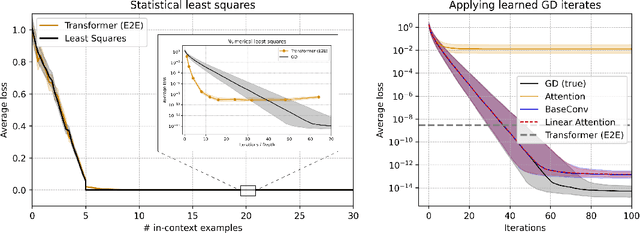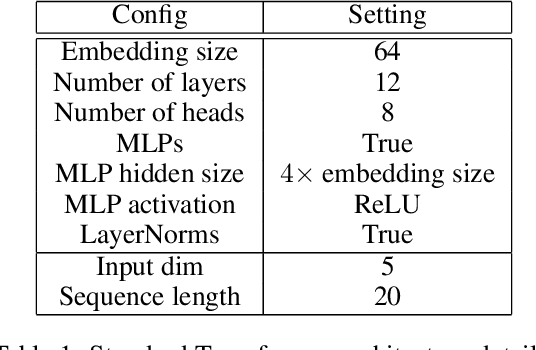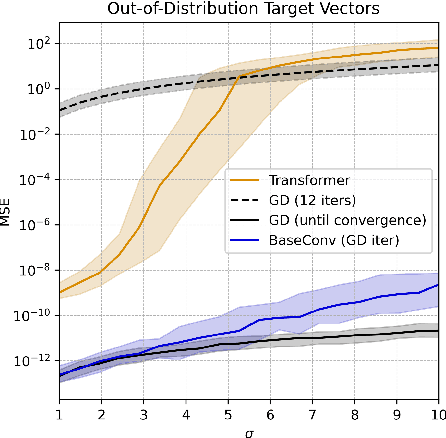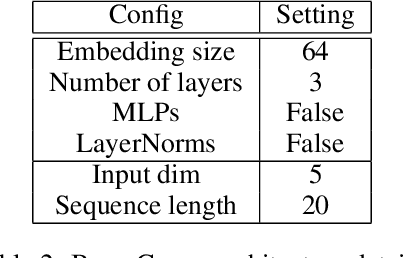Christopher Ré
Department of Computer Science, Stanford University
ParallelKittens: Systematic and Practical Simplification of Multi-GPU AI Kernels
Nov 17, 2025Abstract:Inter-GPU communication has become a major bottleneck for modern AI workloads as models scale and improvements in hardware compute throughput outpace improvements in interconnect bandwidth. Existing systems mitigate this through compute-communication overlap but often fail to meet theoretical peak performance across heterogeneous workloads and new accelerators. Instead of operator-specific techniques, we ask whether a small set of simple, reusable principles can systematically guide the design of optimal multi-GPU kernels. We present ParallelKittens (PK), a minimal CUDA framework that drastically simplifies the development of overlapped multi-GPU kernels. PK extends the ThunderKittens framework and embodies the principles of multi-GPU kernel design through eight core primitives and a unified programming template, derived from a comprehensive analysis of the factors that govern multi-GPU performance$\unicode{x2014}$data-transfer mechanisms, resource scheduling, and design overheads. We validate PK on both Hopper and Blackwell architectures. With fewer than 50 lines of device code, PK achieves up to $2.33 \times$ speedup for data- and tensor-parallel workloads, $4.08 \times$ for sequence-parallel workloads, and $1.22 \times$ for expert-parallel workloads.
Intelligence per Watt: Measuring Intelligence Efficiency of Local AI
Nov 14, 2025Abstract:Large language model (LLM) queries are predominantly processed by frontier models in centralized cloud infrastructure. Rapidly growing demand strains this paradigm, and cloud providers struggle to scale infrastructure at pace. Two advances enable us to rethink this paradigm: small LMs (<=20B active parameters) now achieve competitive performance to frontier models on many tasks, and local accelerators (e.g., Apple M4 Max) run these models at interactive latencies. This raises the question: can local inference viably redistribute demand from centralized infrastructure? Answering this requires measuring whether local LMs can accurately answer real-world queries and whether they can do so efficiently enough to be practical on power-constrained devices (i.e., laptops). We propose intelligence per watt (IPW), task accuracy divided by unit of power, as a metric for assessing capability and efficiency of local inference across model-accelerator pairs. We conduct a large-scale empirical study across 20+ state-of-the-art local LMs, 8 accelerators, and a representative subset of LLM traffic: 1M real-world single-turn chat and reasoning queries. For each query, we measure accuracy, energy, latency, and power. Our analysis reveals $3$ findings. First, local LMs can accurately answer 88.7% of single-turn chat and reasoning queries with accuracy varying by domain. Second, from 2023-2025, IPW improved 5.3x and local query coverage rose from 23.2% to 71.3%. Third, local accelerators achieve at least 1.4x lower IPW than cloud accelerators running identical models, revealing significant headroom for optimization. These findings demonstrate that local inference can meaningfully redistribute demand from centralized infrastructure, with IPW serving as the critical metric for tracking this transition. We release our IPW profiling harness for systematic intelligence-per-watt benchmarking.
HipKittens: Fast and Furious AMD Kernels
Nov 11, 2025Abstract:AMD GPUs offer state-of-the-art compute and memory bandwidth; however, peak performance AMD kernels are written in raw assembly. To address the difficulty of mapping AI algorithms to hardware, recent work proposes C++ embedded and PyTorch-inspired domain-specific languages like ThunderKittens (TK) to simplify high performance AI kernel development on NVIDIA hardware. We explore the extent to which such primitives -- for explicit tile-based programming with optimized memory accesses and fine-grained asynchronous execution across workers -- are NVIDIA-specific or general. We provide the first detailed study of the programming primitives that lead to performant AMD AI kernels, and we encapsulate these insights in the HipKittens (HK) programming framework. We find that tile-based abstractions used in prior DSLs generalize to AMD GPUs, however we need to rethink the algorithms that instantiate these abstractions for AMD. We validate the HK primitives across CDNA3 and CDNA4 AMD platforms. In evaluations, HK kernels compete with AMD's hand-optimized assembly kernels for GEMMs and attention, and consistently outperform compiler baselines. Moreover, assembly is difficult to scale to the breadth of AI workloads; reflecting this, in some settings HK outperforms all available kernel baselines by $1.2-2.4\times$ (e.g., $d=64$ attention, GQA backwards, memory-bound kernels). These findings help pave the way for a single, tile-based software layer for high-performance AI kernels that translates across GPU vendors. HipKittens is released at: https://github.com/HazyResearch/HipKittens.
HMAR: Efficient Hierarchical Masked Auto-Regressive Image Generation
Jun 04, 2025Abstract:Visual Auto-Regressive modeling (VAR) has shown promise in bridging the speed and quality gap between autoregressive image models and diffusion models. VAR reformulates autoregressive modeling by decomposing an image into successive resolution scales. During inference, an image is generated by predicting all the tokens in the next (higher-resolution) scale, conditioned on all tokens in all previous (lower-resolution) scales. However, this formulation suffers from reduced image quality due to the parallel generation of all tokens in a resolution scale; has sequence lengths scaling superlinearly in image resolution; and requires retraining to change the sampling schedule. We introduce Hierarchical Masked Auto-Regressive modeling (HMAR), a new image generation algorithm that alleviates these issues using next-scale prediction and masked prediction to generate high-quality images with fast sampling. HMAR reformulates next-scale prediction as a Markovian process, wherein the prediction of each resolution scale is conditioned only on tokens in its immediate predecessor instead of the tokens in all predecessor resolutions. When predicting a resolution scale, HMAR uses a controllable multi-step masked generation procedure to generate a subset of the tokens in each step. On ImageNet 256x256 and 512x512 benchmarks, HMAR models match or outperform parameter-matched VAR, diffusion, and autoregressive baselines. We develop efficient IO-aware block-sparse attention kernels that allow HMAR to achieve faster training and inference times over VAR by over 2.5x and 1.75x respectively, as well as over 3x lower inference memory footprint. Finally, HMAR yields additional flexibility over VAR; its sampling schedule can be changed without further training, and it can be applied to image editing tasks in a zero-shot manner.
Towards Learning High-Precision Least Squares Algorithms with Sequence Models
Mar 15, 2025



Abstract:This paper investigates whether sequence models can learn to perform numerical algorithms, e.g. gradient descent, on the fundamental problem of least squares. Our goal is to inherit two properties of standard algorithms from numerical analysis: (1) machine precision, i.e. we want to obtain solutions that are accurate to near floating point error, and (2) numerical generality, i.e. we want them to apply broadly across problem instances. We find that prior approaches using Transformers fail to meet these criteria, and identify limitations present in existing architectures and training procedures. First, we show that softmax Transformers struggle to perform high-precision multiplications, which prevents them from precisely learning numerical algorithms. Second, we identify an alternate class of architectures, comprised entirely of polynomials, that can efficiently represent high-precision gradient descent iterates. Finally, we investigate precision bottlenecks during training and address them via a high-precision training recipe that reduces stochastic gradient noise. Our recipe enables us to train two polynomial architectures, gated convolutions and linear attention, to perform gradient descent iterates on least squares problems. For the first time, we demonstrate the ability to train to near machine precision. Applied iteratively, our models obtain 100,000x lower MSE than standard Transformers trained end-to-end and they incur a 10,000x smaller generalization gap on out-of-distribution problems. We make progress towards end-to-end learning of numerical algorithms for least squares.
CodeMonkeys: Scaling Test-Time Compute for Software Engineering
Jan 24, 2025Abstract:Scaling test-time compute is a promising axis for improving LLM capabilities. However, test-time compute can be scaled in a variety of ways, and effectively combining different approaches remains an active area of research. Here, we explore this problem in the context of solving real-world GitHub issues from the SWE-bench dataset. Our system, named CodeMonkeys, allows models to iteratively edit a codebase by jointly generating and running a testing script alongside their draft edit. We sample many of these multi-turn trajectories for every issue to generate a collection of candidate edits. This approach lets us scale "serial" test-time compute by increasing the number of iterations per trajectory and "parallel" test-time compute by increasing the number of trajectories per problem. With parallel scaling, we can amortize up-front costs across multiple downstream samples, allowing us to identify relevant codebase context using the simple method of letting an LLM read every file. In order to select between candidate edits, we combine voting using model-generated tests with a final multi-turn trajectory dedicated to selection. Overall, CodeMonkeys resolves 57.4% of issues from SWE-bench Verified using a budget of approximately 2300 USD. Our selection method can also be used to combine candidates from different sources. Selecting over an ensemble of edits from existing top SWE-bench Verified submissions obtains a score of 66.2% and outperforms the best member of the ensemble on its own. We fully release our code and data at https://scalingintelligence.stanford.edu/pubs/codemonkeys.
Context Clues: Evaluating Long Context Models for Clinical Prediction Tasks on EHRs
Dec 09, 2024



Abstract:Foundation Models (FMs) trained on Electronic Health Records (EHRs) have achieved state-of-the-art results on numerous clinical prediction tasks. However, most existing EHR FMs have context windows of <1k tokens. This prevents them from modeling full patient EHRs which can exceed 10k's of events. Recent advancements in subquadratic long-context architectures (e.g., Mamba) offer a promising solution. However, their application to EHR data has not been well-studied. We address this gap by presenting the first systematic evaluation of the effect of context length on modeling EHR data. We find that longer context models improve predictive performance -- our Mamba-based model surpasses the prior state-of-the-art on 9/14 tasks on the EHRSHOT prediction benchmark. For clinical applications, however, model performance alone is insufficient -- robustness to the unique properties of EHR is crucial. Thus, we also evaluate models across three previously underexplored properties of EHR data: (1) the prevalence of "copy-forwarded" diagnoses which creates artificial repetition of tokens within EHR sequences; (2) the irregular time intervals between EHR events which can lead to a wide range of timespans within a context window; and (3) the natural increase in disease complexity over time which makes later tokens in the EHR harder to predict than earlier ones. Stratifying our EHRSHOT results, we find that higher levels of each property correlate negatively with model performance, but that longer context models are more robust to more extreme levels of these properties. Our work highlights the potential for using long-context architectures to model EHR data, and offers a case study for identifying new challenges in modeling sequential data motivated by domains outside of natural language. We release our models and code at: https://github.com/som-shahlab/long_context_clues
Smoothie: Label Free Language Model Routing
Dec 06, 2024



Abstract:Large language models (LLMs) are increasingly used in applications where LLM inputs may span many different tasks. Recent work has found that the choice of LLM is consequential, and different LLMs may be good for different input samples. Prior approaches have thus explored how engineers might select an LLM to use for each sample (i.e. routing). While existing routing methods mostly require training auxiliary models on human-annotated data, our work explores whether it is possible to perform unsupervised routing. We propose Smoothie, a weak supervision-inspired routing approach that requires no labeled data. Given a set of outputs from different LLMs, Smoothie constructs a latent variable graphical model over embedding representations of observable LLM outputs and unknown "true" outputs. Using this graphical model, we estimate sample-dependent quality scores for each LLM, and route each sample to the LLM with the highest corresponding score. We find that Smoothie's LLM quality-scores correlate with ground-truth model quality (correctly identifying the optimal model on 9/14 tasks), and that Smoothie outperforms baselines for routing by up to 10 points accuracy.
RedPajama: an Open Dataset for Training Large Language Models
Nov 19, 2024Abstract:Large language models are increasingly becoming a cornerstone technology in artificial intelligence, the sciences, and society as a whole, yet the optimal strategies for dataset composition and filtering remain largely elusive. Many of the top-performing models lack transparency in their dataset curation and model development processes, posing an obstacle to the development of fully open language models. In this paper, we identify three core data-related challenges that must be addressed to advance open-source language models. These include (1) transparency in model development, including the data curation process, (2) access to large quantities of high-quality data, and (3) availability of artifacts and metadata for dataset curation and analysis. To address these challenges, we release RedPajama-V1, an open reproduction of the LLaMA training dataset. In addition, we release RedPajama-V2, a massive web-only dataset consisting of raw, unfiltered text data together with quality signals and metadata. Together, the RedPajama datasets comprise over 100 trillion tokens spanning multiple domains and with their quality signals facilitate the filtering of data, aiming to inspire the development of numerous new datasets. To date, these datasets have already been used in the training of strong language models used in production, such as Snowflake Arctic, Salesforce's XGen and AI2's OLMo. To provide insight into the quality of RedPajama, we present a series of analyses and ablation studies with decoder-only language models with up to 1.6B parameters. Our findings demonstrate how quality signals for web data can be effectively leveraged to curate high-quality subsets of the dataset, underscoring the potential of RedPajama to advance the development of transparent and high-performing language models at scale.
Aioli: A Unified Optimization Framework for Language Model Data Mixing
Nov 08, 2024Abstract:Language model performance depends on identifying the optimal mixture of data groups to train on (e.g., law, code, math). Prior work has proposed a diverse set of methods to efficiently learn mixture proportions, ranging from fitting regression models over training runs to dynamically updating proportions throughout training. Surprisingly, we find that no existing method consistently outperforms a simple stratified sampling baseline in terms of average test perplexity per group. In this paper, we study the cause of this inconsistency by unifying existing methods into a standard optimization framework. We show that all methods set proportions to minimize total loss, subject to a method-specific mixing law -- an assumption on how loss is a function of mixture proportions. We find that existing parameterizations of mixing laws can express the true loss-proportion relationship empirically, but the methods themselves often set the mixing law parameters inaccurately, resulting in poor and inconsistent performance. Finally, we leverage the insights from our framework to derive a new online method named Aioli, which directly estimates the mixing law parameters throughout training and uses them to dynamically adjust proportions. Empirically, Aioli outperforms stratified sampling on 6 out of 6 datasets by an average of 0.28 test perplexity points, whereas existing methods fail to consistently beat stratified sampling, doing up to 6.9 points worse. Moreover, in a practical setting where proportions are learned on shorter runs due to computational constraints, Aioli can dynamically adjust these proportions over the full training run, consistently improving performance over existing methods by up to 12.01 test perplexity points.
 Add to Chrome
Add to Chrome Add to Firefox
Add to Firefox Add to Edge
Add to Edge